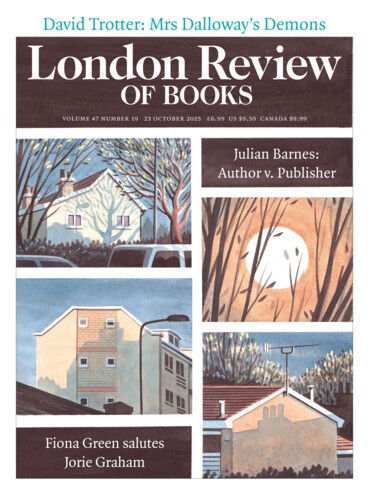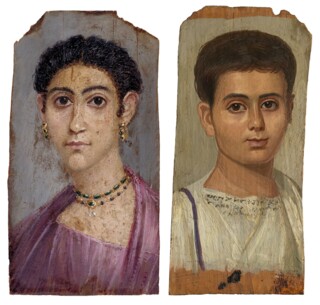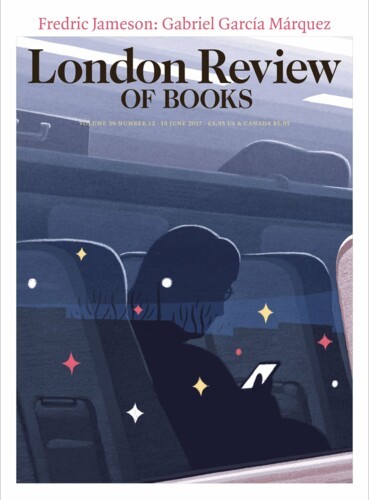The Annual Report of the Director of the National Gallery for 1888 announced the display of three painted wooden panels ‘under glass’. The panels were almost two thousand years old and had been unearthed the year before from Roman-period cemeteries in Hawara, in the Fayum basin in Egypt, where they had been placed over the faces of mummies and integrated into their wrappings. Before arriving at the National Gallery they had been shown in the ostentatious Egyptian Hall on Piccadilly, where the archaeologist W.M. Flinders Petrie exhibited his discoveries. There, they had overlooked a crowded display of complete mummies and other finds from the Fayum. Stripped from their mummies and hung on the walls of the National Gallery, alongside Holbeins and Van Dycks, the panels were presented as if they were the earliest examples of European portrait painting.
In accordance with the practice at the time, the Service des Antiquités de l’Égypte had the first pick of the mummy portraits, after which Petrie distributed some to individuals and institutions that had sponsored his excavations. One was offered to Girton College, Cambridge; it bears its subject’s Greek name and title, ‘Hermione, Grammatike’, which tells us she was a teacher. Petrie thought her well matched to ‘a women’s college’, and a group of third-year students raised £20 for the purchase. Petrie, whose advances in stratigraphic excavation and typological analysis are today overshadowed by his racism and belief in eugenics, described the installation: ‘She herself now stands in the library of Girton College, once again surrounded by books and girl students, whom she doubtless loved well, long before the Goth and the Arab had broken up her old culture.’
The paintings of Hermione and her contemporaries from Hawara are stunning. Their production began around 30-40 ce, sixty or so years after the defeat of Antony and Cleopatra at Actium and the beginning of Roman rule. This brought to an end almost three hundred years of governance by the Ptolemies, the Greek-speaking Macedonian dynasty that had succeeded Alexander the Great in Egypt. The panel paintings were an innovation that combined the Roman tradition of commemorating the dead through naturalistic portraiture (most enduringly in stone sculpture) with the ancient Egyptian practice of mummification.
Most of the mummy portraits were discovered in the Fayum, a depression formed by an ancient lake in the desert close to the apex of the Nile Delta. Among sites along the Nile, a significant number of mummies bearing painted wooden panels and shrouds were found at Antinoöpolis, the city founded by Hadrian on the spot where his lover, Antinoös, was said to have drowned. New excavations have provided greater archaeological context: in the 1990s at Marina el-Alamein on the Mediterranean coast and, more recently, at er-Rubayat (ancient Philadelphia).
Petrie’s finds from Hawara and Albert Gayet’s from Antinoöpolis both caused a sensation when they were exhibited, but the mummy portraits were not examined in great detail. For most of the following century, as the corpus of mummy portraits grew, neither Romanists nor Egyptologists seemed interested in claiming them. Academics, mostly writing in German, were more preoccupied with chronology and distinguishing the features of one civilisation from another than with attending to local practices, however remarkable. Only after the publication of a four-volume survey by Klaus Parlasca, Mumienporträts und verwandte Denkmäler (1975-2003), did critical scholarship begin to increase, coinciding with a shift in classical studies towards interdisciplinarity and a wider recognition of the social context of changes in burial practice.
Euphrosyne Doxiadis, a painter and art historian, brought the subject to a general readership in 1995, when the first edition of The Mysterious Fayum Portraits was published. A new foreword by the novelist (and former British Museum trustee) Ahdaf Soueif, replacing the original by the ancient historian (and fellow of Girton) Dorothy J. Thompson, is almost the only suggestion that things have changed over the thirty years since the book’s initial publication.
From the beginning, photography and innovations in printing were key to the paintings’ dissemination. Petrie returned to Hawara in 1911-12 and reported that ‘colour-work has advanced so much that the portraits can be efficiently published.’ However, ‘to issue the whole of the colour plates in the usual volumes would be impracticable, as these already here cost nearly as much as an ordinary volume.’ His Hawara Portfolio (1913) comprised 24 colour images pasted onto card. Petrie wrote that he hoped his presentation of ‘facsimiles of classical portraiture’ would lead to further such volumes, making ‘other examples preserved in museums … available for study and comparison’.
The high-resolution illustrations in Doxiadis’s book, many of them by the portrait photographer Lucinda Douglas-Menzies, made the panels widely accessible for the first time. The detail and size of the images allows the reader to appreciate the three-dimensionality of portraits in which the layers of pigment were applied with a spatula rather than a brush. Doxiadis’s close observation and detailed knowledge are evident in her descriptions, such as this one of a male portrait dated around 140-60 CE: ‘The sense of energy is intensified by the thick impasto of the painting in the areas of the flesh and hair; free confident brushstrokes on the white garments contrast with short, controlled marks made by both brushes and a hard tool on the portrait itself.’ The book is organised according to archaeological site, making it easier to identify individual workshops and regional variations, and to make educated guesses about portraits of unknown origin. While the dating of some of the panel paintings was once controversial, a rigorous analysis by Barbara Borg, included in summary form at the end of the book, remains the standard interpretation. While some scholars had argued that poorer quality painted panels were of later origin, Borg established a secure chronology by comparing hairstyles, costumes and jewellery with dated examples from coins and sculpture.
The most significant event in the reception history of the portraits was an exhibition at the British Museum called Ancient Faces: Mummy Portraits from Roman Egypt, a collaboration between the Romanist Susan Walker and the Egyptologist Morris Bierbrier which opened to great acclaim in 1997. The reviewer for the New York Times wrote that ‘such is the intensity of the gaze, the realism of expression, the details of clothes and jewellery and the sophistication of brush strokes that they look like stunning secular artworks of another era.’
The British Museum show went on to Rome and New York. Other exhibitions featuring many of the same or similar works were mounted in 1998 and 1999 in Greece (with Doxiadis editing the catalogue), France, Germany and Austria (the last of which included spectacular loans from the Egyptian Museum in Cairo). As a result of these exhibitions and the conservation needs of the panels, major advances have been made in identifying their materials and understanding the manner of their production. At the time of the British Museum exhibition, the archaeobotanist Caroline Cartwright found that most of the panels were made from southern European lime wood, showing that it wasn’t only a preference for naturalistic portraiture that had been imported to Egypt from the Roman Empire but also some of the materials. This initiated a whole new phase of scientific inquiry.
Since 2013 the Getty-funded APPEAR project (Ancient Panel Paintings: Examination, Analysis and Research) has become a hub for knowledge exchange between sixty participating institutions. With the advent of digital technology Petrie’s ambition has finally been realised: direct comparisons between panels from the various regional workshops. The systematic collection and publication of data has refined earlier results and generated new ones. While academics were once preoccupied with categorising the painting technique as tempera or encaustic (in which pigments are suspended in beeswax), chemical analysis has shown that most of the portraits employed a mixture. The development of multispectral imaging has enabled non-destructive analysis of the pigments, revealing the chemical composition of their exquisite colours (those pinks!), both imported and locally produced, natural and artificial. It would have been helpful if the new edition of Doxiadis’s book had taken stock of these discoveries.
There are almost a thousand portraits on wooden panels or linen shrouds in international museum collections, a large number of them in Egypt. Most are mummy portraits, though some funerary portraits, usually found in eight-point frames (made from four intersecting pieces of wood), also survive. Doxiadis illustrates a third type of portrait: contemporary votive panels depicting deities. Like the mummy portraits, they render in two dimensions subjects better known from relief and sculpture. Some of the panels represent a pantheon that is shown in similar naturalistic style elsewhere (Isis, Serapis, Dionysus); others are more surprising, such as a panel showing the fertility god Min with an erect penis, although Min was usually portrayed in ancient Egyptian style. The identification of others has required systematic study: the god Heron, for example, was virtually unknown before the Egyptologist Vincent Rondot’s comprehensive survey of the 53 votive portraits in international collections. The same group has been interpreted by the art historian Thomas Mathews as the origin of the Christian icon, a theory Doxiadis also developed.
While the panel paintings were what attracted her to the subject, Doxiadis’s book also illustrates the plaster masks and linen shrouds that were part of the Egyptian funerary industry. The individual features of the dead are more convincingly portrayed in the panels and shrouds, but are discernible on some plaster masks too. In all three media, the apparent naturalism of the portraits clashes with the formalism of ancient Egyptian funerary scenes. The mummy case of a young man called Artemidorus, for instance, has a painted panel at the top showing an alert young man with dark eyes and pursed lips, while below him are a series of traditional Egyptian funerary scenes in gold leaf.
The contrast of Roman portraiture and Egyptian mummification gives rise to a trickier question: were the subjects and makers of funerary portraits Egyptians, Greeks or Romans? The Fayum was home to Egyptians and Greeks as well as increasing numbers of people from the wider Roman Empire. Doxiadis describes the portraits as ‘Greek works’ and traces their origins to Greek artisans who arrived after the Macedonian conquest. This is another place where the text should have been updated. Some of the phrases she uses are jarring, such as the references to a ‘pure Greek community’ and ‘racial origins’. It is not so much that the broad interpretation has been challenged: these people were undeniably members of the elite, probably held metropolitan status (meaning that men paid a reduced poll tax) and would mostly have been descendants of non-Egyptians. But the nuances of language have changed, as have the research questions. Combinations of real or perceived descent, language, dress and appearance, religious and other cultural norms were presented differently by individuals and families according to context, as academics have increasingly recognised.
The permeability of the categories Egyptian, Greek and Roman, as well as Syrian, Libyan and Persian, has become clearer as a result of the papyrological evidence of the last thirty years (work advanced by Dorothy J. Thompson, who wrote the original preface). Before the Roman period, the term Greek could be used for various categories of people who were not Egyptian. It was primarily a tax status, so could be held by a man whose brother was categorised as Egyptian. Under the Roman legal system, Greek became a subcategory of Egyptian. People could have two names, one Greek and one Egyptian, to be used according to the audience and occasion. Small wooden mummy labels bearing the occupant’s name in Greek on one side and Egyptian on the other form some of the best evidence for the practice of double names. The Greek side gives the father’s name, while the Egyptian side sometimes also gives the mother’s. When mummies with painted panels are inscribed, their names are usually given in their Greek form and in Greek script. There are exceptions: a panel from Tebtunis in the Fayum has the Egyptian name Thaubarion transliterated into Greek and a prayer for a woman with the Greek name Eirene is written in Egyptian.
A sketch portrait from Tebtunis gives us rare access to the language of the workshop. The instructions to the artist (‘paint the eyes softer … she wears a green necklace’) are in Greek. Everyday documents surviving on papyrus reveal something of the people involved in the industry. A recently published archive of Greek documents records several generations of families of undertakers active in Egypt’s Western Desert in the third and early fourth centuries ce. They have Egyptian names rendered in Greek, such as Petosiris (‘he who was given by Osiris’) and Petechonsis (‘he who was given by Chonsu’). The families led middle-class lives despite being unable to read: they owned property and hired lawyers in the course of their business.
After a few hundred years the taste for painted panels seems to have faded. By the middle of the third century ce, a sleeved tunic with broad stripes, known as a dalmatic, had become the standard dress for women. These rarely appear on panel paintings, but can be found on painted linen shrouds from Antinoöpolis, where the best evidence survives for the continuation of the funerary portrait tradition into late antiquity.
Send Letters To:
The Editor
London Review of Books,
28 Little Russell Street
London, WC1A 2HN
letters@lrb.co.uk
Please include name, address, and a telephone number.


